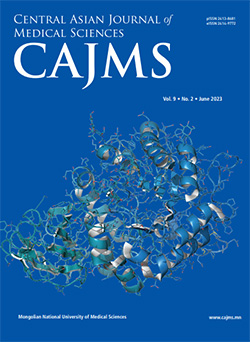Association of Anthropometric Parameters and Severity of SARS-COV-2 Infection among Hospitalized Patients in a Tertiary care Center in Western Maharashtra – an Analytical Cross-Sectional Study
DOI:
https://doi.org/10.24079/cajms.2023.06.002Keywords:
Anthropometry, COVID-19, Severity of Illness, Hospitalization, Risk FactorsAbstract
Background: On March 11, 2020, the World Health Organization (WHO) confirmed COVID-19 as a pandemic. COVID-19 has infected more than 5.5 million people worldwide, resulting in more than 3,47,000 fatalities. Obese individuals may be more susceptible to infection with SARSCoV-2. This study was conducted to assess the association between anthropometric parameters and the severity of SARS-CoV-2 infection.
Methodology: This analytical cross-sectional study was undertaken on COVID-19-positive patients admitted to COVID-dedicated wards at a tertiary care center in Pune. The data was collected using a convenient sampling method from 185 COVID-19-positive patients.
Result: Among those Positive for SARS-COV-2, 128 (69.19%) patients had mild COVID-19, and 57 (30.81%) patients were having severe COVID-19 disease. 36 patients (28.13%) with mild COVID-19 disease were average weight, 48 patients (37.50%) were overweight, and 42 patients (32.81%) were obese. Three (5.26%) of the 57 patients with severe COVID-19 disease were overweight, and 54 (94.74%) were obese. 19 (10.2%) patients had previously been diagnosed with hypertension, and 22 (11.8%) patients had both hypertension and diabetes.
Conclusion: Obesity in patients with COVID-19 was associated with severe diseases, particularly pneumonia. Patients having underlying medical illnesses like hypertension and diabetes were found to be at higher risk of severe COVID-19.
Downloads
255
References
Center for Systems Science and Engineering (CSSE) at Johns Hopkins University. Coronavirus COVID-19 global cases. Published 2023. Accessed March 20, 2023. https://coronavirus.jhu.edu/map.html.
World Health Organization. Coronavirus disease (COVID-19) situation report-124. Published May 23, 2020. Accessed March 20, 2023. https://www.who.int/emergencies/diseases/novel-coronavirus-2019/situation-reports.
Goyal P, Choi JJ, Pinheiro LC, et al. Clinical characteristics of COVID-19 in New York City. N Engl J Med. 2020;382(24):2372-2374. https://doi.org/10.1056/NEJMc2010419 PMid:32302078 PMCid:PMC7182018
Keys A, Fidanza F, Karvonen MJ, Kimura N, Taylor HL. Indices of relative weight and Obesity. J Chron Dis. 1972;25(6):329-43. https://doi.org/10.1016/0021-9681(72)90027-6 PMid:4650929
Ghoorah K, Campbell P, Kent A, et al. Obesity and Cardiovascular Outcomes: A Review. Eur Heart J Acute Cardiovasc Care. 2016;5(1):77-85. https://doi.org/10.1177/2048872614523349 PMid:24526749
Nimptsch K, Konigorski S, Pischon T. Diagnosis of Obesity and Use of Obesity Biomarkers in Science and Clinical Medicine. Metabolism. 2019;92:61-70. https://doi.org/10.1016/j.metabol.2018.12.006 PMid:30586573
Huttunen R, Syrjänen J. Obesity and the risk and outcome of infection. Int J Obes (Lond). 2013;37(3):333-340. https://doi.org/10.1038/ijo.2012.62 PMid:22546772
Misumi I, Starmer J, Uchimura T, et al. Obesity expands a distinct population of T cells in adipose tissue and increases vulnerability to infection. Cell Rep. 2019;27:514-524. https://doi.org/10.1016/j.celrep.2019.03.030 PMid:30970254 PMCid:PMC6652206
Pradeepa R, Anjana RM, Joshi SR, et al. Prevalence of generalized and abdominal Obesity in urban and rural India. Indian J Med Res. 2015;142(August):139-150. https://doi.org/10.4103/0971-5916.164234 PMid:26354211 PMCid:PMC4613435
Wong CK, Lam CW, Wu AK, et al. Plasma Inflammatory Cytokines and Chemokines in Severe Acute Respiratory Syndrome. Clin Exp Immunol. 2004;136(1):95-103. https://doi.org/10.1111/j.1365-2249.2004.02415.x PMid:15030519 PMCid:PMC1808997
World Health Organization, International Obesity Task Force (IOTF), International Association for the Study of Obesity (IASO). The Asia-Pacific perspective: Redefining Obesity and its treatment. Published 2000. Accessed March 20, 2023. https://apps.who.int/iris/handle/10665/206936
Integrated Disease Surveillance Project (IDSP) NCD Risk Factor Surveillance. Training manual for field workers and field supervisors. Published 2005. Accessed March 20, 2023. https://main.icmr.nic.in/sites/default/files/reports/Phase-1_States_of_India.pdf.
World Health Organization. WHO R&D Blueprint Novel Coronavirus COVID-19 Therapeutic Trial Synopsis. Published 2020. Accessed March 20, 2023. https://www.who.int/blueprint/priority-diseases/key-action/COVID-19_Treatment_Trial_Design_Master_Protocol_synopsis_Final_18022020.
Pei-Fang Wei. Diagnosis and Treatment Protocol for Novel Coronavirus Pneumonia. Chin Med J (Engl). 2020;133(9):1087-1095. https://doi.org/10.1097/CM9.0000000000000819 PMid:32358325 PMCid:PMC7213636
World Health Organization Western Pacific Region, International Association for the Study of Obesity, International Obesity Task Force. Appropriate body mass index for Asian populations and its implications for policy and intervention strategies. Lancet. 2004;363(9403):157-163. https://doi.org/10.1016/S0140-6736(03)15268-3 PMid:14726171
Chen C, Lu FC; Department of Disease Control Ministry of Health, PR China. The guidelines for prevention and control of overweight and obesity in Chinese adults. Biomed Environ Sci. 2004;17 Suppl:1-36. https://pubmed.ncbi.nlm.nih.gov/15807475/
Wang Y, Wang L, Qu W. New national data show an alarming increase in Obesity and noncommunicable chronic diseases in China. Eur J Clin Nutr. 2017;71(1):149-150. https://doi.org/10.1038/ejcn.2016.171 PMid:27703162
Marie NG, Fleming T, Robinson M, et al. Global, regional, and national prevalence of overweight and Obesity in children and adults during 1980-2013. Lancet. 2014;384:766-781. https://doi.org/10.1016/S0140-6736(14)60460-8 PMid:24880830
Dietz W, Santosburgoa C. Obesity and its implications for COVID-19 mortality. Obesity (Silver Spring). 2020;28:1005-1005. https://doi.org/10.1002/oby.22818 PMid:32237206
Hales CM, Carroll MD, Fryar CD, Ogden CL. Prevalence of Obesity Among Adults and Youth: United States, 2015-2016. NCHS Data Brief. 2017;288:1-8. https://www.cdc.gov/nchs/data/databriefs/db288.pdf
Ruan Y, Wei L, Liu J, et al. The role of anthropometric parameters in predicting disease severity in COVID-19 patients. Clin. Infect. Dis. 2022;25(6):580-589.
Sanchis-Gomar F, Lavie CJ, Mehra MR, et al. Obesity and outcomes in COVID-19: When an epidemic and pandemic collide. Mayo Clin Proc. 2020;95(7):1445-1453. https://doi.org/10.1016/j.mayocp.2020.05.006 PMid:32622449 PMCid:PMC7236707
Petersen A, Bressem K, Albrecht J, et al. The impact of body mass index on the severity of COVID-19: A systematic review and meta-analysis. Obes. Med. 2021;24:100317.
Hajifathalian K, Kumar S, Newberry C, et al. Obesity is associated with worse outcomes in COVID-19: Analysis of early data from New York City. Obesity. 2020;28(9):1606-1612. https://doi.org/10.1002/oby.22923 PMid:32470210 PMCid:PMC7283831
Korakas E, Ikonomidis I, Kousathana F, et al. Obesity and COVID-19: Immune and metabolic derangement as a possible link to adverse clinical outcomes. Am J Physiol Endocrinol and Metab. 2020;319(1):E105-E109. https://doi.org/10.1152/ajpendo.00198.2020 PMid:32459524 PMCid:PMC7322508
Downloads
Published
How to Cite
Issue
Section
License
Copyright (c) 2023 Mongolian National University of Medical Sciences

This work is licensed under a Creative Commons Attribution-NonCommercial 4.0 International License.




